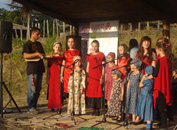|
Friday,
July 27,
2007, #142 (1409)
 Art Gene 2007: Spirit of Georgia on the Road Art Gene 2007: Spirit of Georgia on the Road
By Christina Tashkevich
Art Gene festival is undoubtedly a gem among festivals. And this is not empty praise to one of its organizers, a musician I truly take my hat off to—Zaza Korinteli (aka Zumba). It’s rather a true admiration of the work started by Zumba and his friends four years ago, who created a folk festival which now every year brings the best of Georgian folk art traditions to the public.
This year’s Art Gene moved out of the capital and toured throughout the provinces of Georgia. And in my opinion that’s what it should all be about when you talk about Georgian folk traditions. In previous years, the festival gathered craftsmen as well as musicians and dancers from the provinces and brought them to Tbilisi to show off their skills. This year, the idea was to leave the big city, and be soaked in the regional palette. Zumba and his friends went ‘village-to-village’ for two months exploring the rich folk traditions where they were born.
One such place was Rukhi castle, located just a few meters away from the Georgian–Abkhaz border. Zumba is the author and performer of the Abkhazia-inspired song “Gamarjoba Abkhazeto Sheni” (Greetings, Abkhazia) which won this year’s patriotic song contest in Tbilisi.
Another spot visited worth mentioning was the out-of-the-way village Chargali in Pshavi district, high in the mountains, which is also the birthplace of the great Georgian writer Vazha-Pshavela.

|
South Ossetia has not been forgotten at this year’s Art Gene as well. Last week, Tbilisi’s Ethnographic Museum (the location of the festival), hosted a day of Ossetian culture. Georgians and Ossetians sat side-by-side at wood tables tasting Ossetian potato and cheese khachapuri, toasting each other and enjoying a little Ossetian song and dance.
The final week of the almost two-month long festival was held in Tbilisi, bringing the best performers and craftsmen ‘in the field’ to the capital. The open-air Ethnographic Museum near Turtle Lake housed the exhibition of crafts, Georgian cuisine, shows of traditional martial arts, and, of course, concerts in the museum’s amphitheatre.
Promoting Georgian traditional arts is without a doubt a primary goal of the festival. Inevitably, Georgian art—whether it’s carvings or enamel, music or dancing—though it may carry a modern flavour, is deeply rooted in tradition, giving the best of both worlds.
Take for example, the Sukhishvilebi dance group who opened the final week of Art Gene in Tbilisi. Its “ASSA Show” is a collection of traditional Georgian dances with a modern twist.
However, this year’s festival also put an emphasis on tourism development. The festival’s organizers took groups of students to different parts of Georgia and hoped this would foster the development of domestic tourism.
Visiting the final week of the festival at the open-air museum, I was assured once more that this place is the best location for such kind of festivals in Tbilisi. The territory of the open-air museum is vast enough to house a lot of people. The amphitheatre is rather small for the large numbers of people who turned out for the concerts, but it’s really something just to be accepted, rather than a shortcoming, because redesigning the grounds just wouldn’t be right.
We came to the festival on the first day, drawn by the star attraction of the evening: Sukhishviliebi, who turned out to as dazzling as ever. But we were wowed from the minute we walked into the open air museum with the starry sky, the wood benches and tents, the smell of mtzvadi and beer, and finally the illuminated stage.
The audience was as hooked as we were, some people going crazy dancing to the sounds of the performers, others listening attentively. I glanced around the crowd and saw the leader of Georgian alternative band 33a, Niaz Diasamidze. He’s also one of the visionaries of the festival. His keen eye-sight seemed to catch every detail of the show, as I’m sure his ear did with the music.
A lot of people were lamenting the weather, which fairly enough was quite wet. Hours before the concert, heavy rains poured down on Tbilisi and when we called Zumba to find out whether the concert would go on in the rain, he enthusiastically said something like, “Nothing can stop us!”
That was true. In fact, the high spirits around the event is what makes it so great. The rain had stopped by the time of the concert, but the heavy clouds overhead reminded us that the pouring rain may have caught us out in the open with no place to hide.
But no one really cared. The feeling of freedom was thick in the air—it was a feeling of joy and pride that filled me and the people around me.
Leaving the place hours later, we were satisfied and happy. However, many more interesting things lay ahead.
The next concerts featured the best of Georgian music: Nino Katamadze with her band Insight, Niaz Diasamidze with 33a, and, surprise!, Zumba.
Representatives of the Georgian government were also spotted at the festival. Tbilisi Mayor Gigi Ugulava sat with Zumba at the small supra in the open-air museum during one of the first days of the festival. Not that the wine flew like a river at that particular supra, but spirits were high.
And at the last concert of Art Gene 2007, President Saakashvili put in an appearance, giving one more boost to an already exalted festival.
This year’s Art Gene was one of the major highlights of cultural life in Georgia—and by now, I’ve come to expect nothing less from this brilliant festival.


© The Messenger. All
rights reserved. Please read our disclaimer
before using any of the published materials.
|